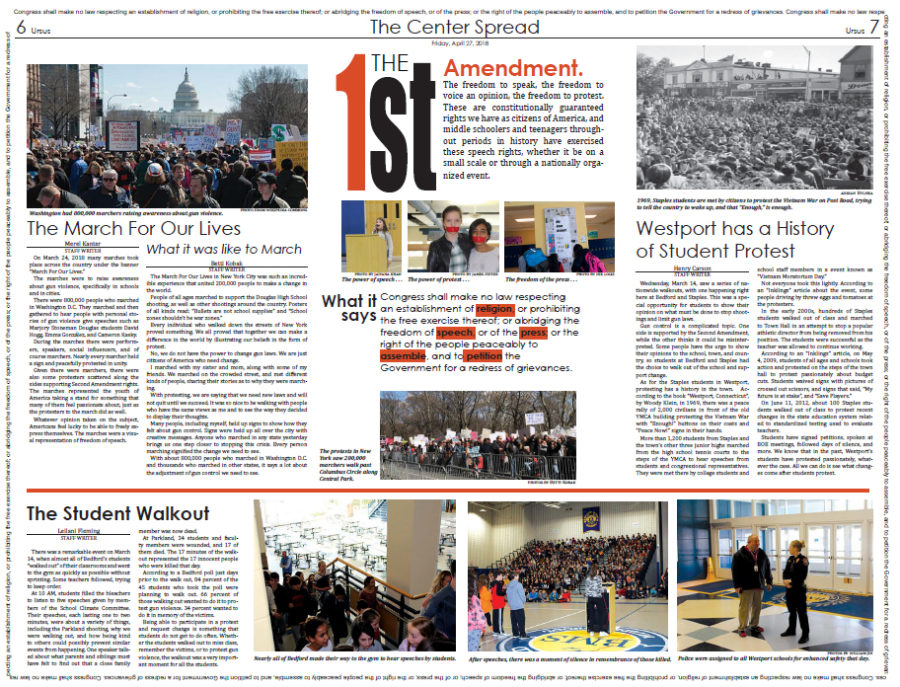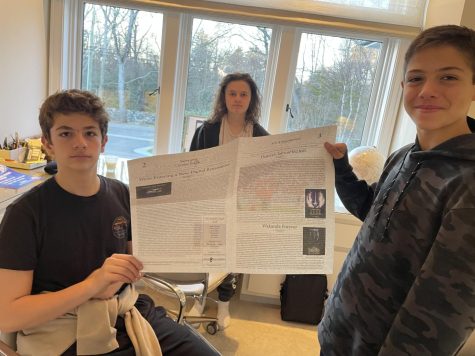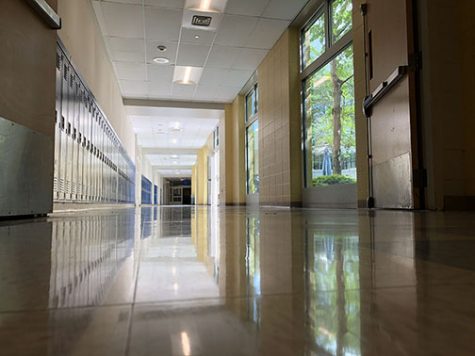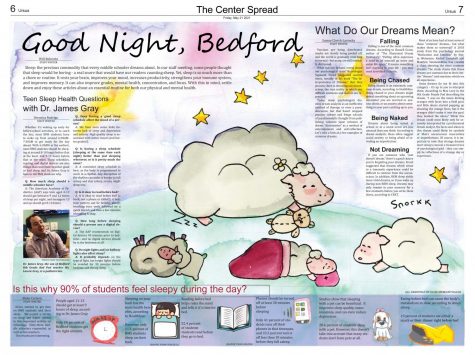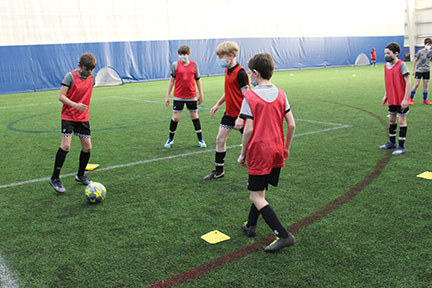1st Amendment at BMS
The freedom to speak, the freedom to voice an opinion, the freedom to protest. These are constitutionally guaranteed rights we have as citizens of America, and middle schoolers and teenagers throughout periods in history have exercised these speech rights, whether it be on a small scale or through a nationally organized event.
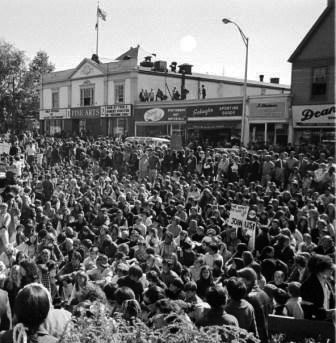
1969, Staples students are met by citizens to protest the Vietnam War on Post Road, trying to tell the country to wake up, and that “Enough,” is enough.
Westport has a History of Student Protest
By Henry Carson
Wednesday, March 14, saw a series of nationwide walkouts, with one happening right here at Bedford and Staples. This was a special opportunity for students to show their opinion on what must be done to stop shootings and limit gun laws.
Gun control is a complicated topic. One side is supported by the Second Amendment, while the other thinks it could be misinterpreted. Some people have the urge to show their opinions to the school, town, and country, so students at Bedford and Staples had the choice to walk out of the school and support change.
Congress shall make no law respecting an establishment of religion, or prohibiting the free exercise thereof; or abridging the freedom of speech, or of the press; or the right of the people peaceably to assemble, and to petition the Government for a redress of grievances.
More than 1,200 students from Staples and the town’s other three junior highs marched from the high school tennis courts to the steps of the YMCA to hear speeches from students and congressional representatives. They were met there by college students and school staff members in a event known as “Vietnam Moratorium Day.”
Not everyone took this lightly. According to an “Inklings” article about the event, some people driving by threw eggs and tomatoes at the protesters.
In the early 2000s, hundreds of Staples students walked out of class and marched to Town Hall in an attempt to stop a popular athletic director from being removed from his position. The students were successful as the teacher was allowed to continue working.
According to an “Inklings” article, on May 4, 2009, students of all ages and schools took action and protested on the steps of the town hall to protest passionately about budget cuts. Students waived signs with pictures of crossed out scissors, and signs that said, “My future is at stake”, and “Save Players.”
On June 11, 2012, about 100 Staples students walked out of class to protest recent changes in the state education system related to standardized testing used to evaluate teachers.
Students have signed petitions, spoken at BOE meetings, followed days of silence, and more. We know that in the past, Westport’s students have protested passionately, whatever the case. All we can do is see what changes come after students protest.
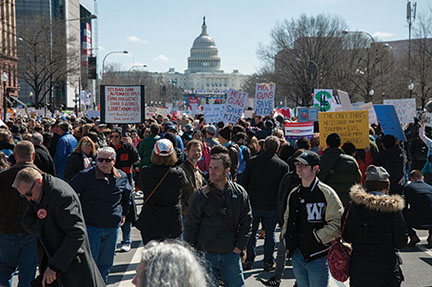
Washington had 800,000 marchers raising awareness about gun violence.
The March for Our Lives
Br Merel Kanter
On March 24, 2018 many marches took place across the country under the banner “March For Our Lives.”
The marches were to raise awareness about gun violence, specifically in schools and in cities.
There were 800,000 people who marched in Washington D.C. They marched and then gathered to hear people with personal stories of gun violence give speeches such as Marjory Stoneman Douglas students David Hogg, Emma González, and Cameron Kasky.
During the marches there were performers, speakers, social influencers, and of course marchers. Nearly every marcher held a sign and peacefully protested in unity.
Given there were marchers, there were also some protesters scattered along the sides supporting Second Amendment rights. The marches represented the youth of America taking a stand for something that many of them feel passionate about, just as the protesters to the march did as well.
Whatever opinion taken on the subject, Americans feel lucky to be able to freely express themselves. The marches were a visual representation of freedom of speech.
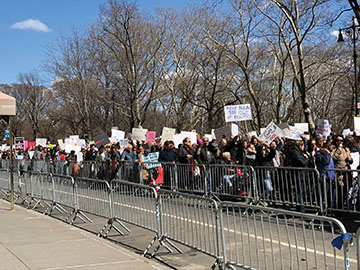
The protests in New York saw 200,000 marchers walk past Columbus Circle along Central Park.
What it was like to March
By Betti Kobak
The March For Our Lives in New York City was such an incredible experience that united 200,000 people to make a change in the world.
People of all ages marched to support the Douglas High School shooting, as well as other shootings around the country. Posters of all kinds read: “Bullets are not school supplies” and “School zones shouldn’t be war zones.”
Every individual who walked down the streets of New York proved something. We all proved that together we can make a difference in the world by illustrating our beliefs in the form of protest.
No, we do not have the power to change gun laws. We are just citizens of America who need change.
I marched with my sister and mom, along with some of my friends. We marched on the crowded street, and met different kinds of people, sharing their stories as to why they were marching.
With protesting, we are saying that we need new laws and will not quit until we succeed. It was so nice to be walking with people who have the same views as me and to see the way they decided to display their thoughts.
Many people, including myself, held up signs to show how they felt about gun control. Signs were held up all over the city with creative messages. Anyone who marched in any state yesterday brings us one step closer to stopping this crisis. Every person marching signified the change we need to see.
With about 800,000 people who marched in Washington D.C. and thousands who marched in other states, it says a lot about the adjustment of gun control we need to see.
The Student Walkout at Bedford
By Leilani Fleming
There was a remarkable event on March 14, when almost all of Bedford’s students “walked out” of their classrooms and went to the gym as quickly as possible without sprinting. Some teachers followed, trying to keep order.
At 10 AM, students filled the bleachers to listen to five speeches given by members of the School Climate Committee. Their speeches, each lasting one to two minutes, were about a variety of things, including the Parkland shooting, why we were walking out, and how being kind to others could possibly prevent similar events from happening. One speaker talked about what parents and siblings must have felt to find out that a close family member was now dead.
At Parkland, 34 students and faculty members were wounded, and 17 of them died. The 17 minutes of the walkout represented the 17 innocent people who were killed that day.
According to a Bedford poll just days prior to the walk out, 84 percent of the 45 students who took the poll were planning to walk out. 66 percent of those walking out wanted to do it to protest gun violence. 34 percent wanted to do it in memory of the victims.
Being able to participate in a protest and request change is something that students do not get to do often. Whether the students walked out to miss class, remember the victims, or to protest gun violence, the walkout was a very important moment for all the students.
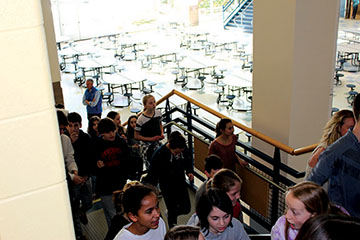
Nearly all of Bedford made their way to the gym to hear speeches by students.
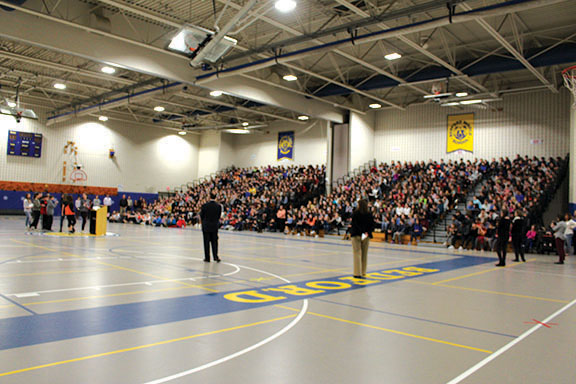
After speeches, there was a moment of silence in remembrance of those killed.

Students wrote two minute speeches expressing how they felt about safety, school violence, and guns in school.
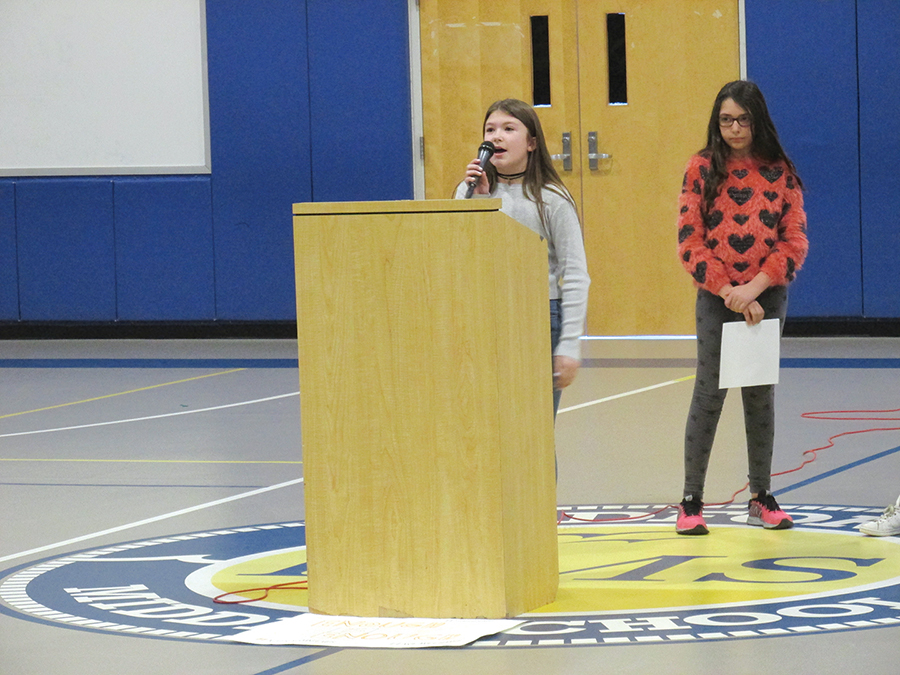
School Climate Committee members spoke at the event.
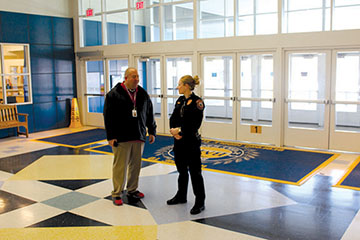
Police were assigned to all Westport schools for enhanced safety that day.



